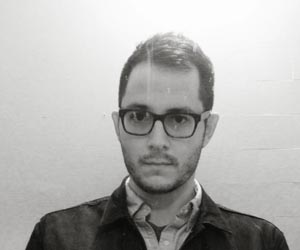The postcard is a mode that evokes simultaneous distance and intimacy. On one side, an image, often one that is emblematic of a particular place; on the other, a blank space for the writer to briefly address one who is elsewhere. The postcard is testament to the physical separation between writer and addressed, an experience not shared. Without sufficient space for the writer to describe and reflect as a way for the recipient to enter the experience secondhand, more than any specific message, the postcard signals the writer’s impulse to speak to the addressed from within that private experience. “NYC postcards,” a recurring title throughout DJ Dolack’s debut collection Whittling a New Face in the Dark, might double as an apt description of Dolack’s poetic style—sparse (though muscular, tough even), grounded in occasion, and voiced in a way that suggests an interlocutor across silence and rift.
“NYC Postcards,” along with other poems in the collection, sometimes foreground New York City itself—particular streets, bars, bridges, a sidewalk scene after a Greenpoint church lets out on Easter Sunday—and they often take on a distinctly urban cast of solitary witness. However, the poems rarely look directly to place for subject matter. New York City is one of many anchors in the real that Dolack uses to remind that these non-narrative poems are specifically located, framed not only by time and space, but by particular moods and states of mind. One of the early “NYC Postcards” locates the speaker in the reverberations of a childhood memory. In its entirety:
Dawn is a color
I am condemned to describemy mother’s penmanship
on the anesthesiologists forms—father holding me
up to the casketso I could search
the dead man’s temple for an
entry wound. Peopletrying hard; people
really trying.
There is much that’s characteristic of the collection in this poem: the slinky, somewhat elusive gravity found in the opening statement; the image of the “mother’s penmanship / on the anesthesiologists forms,” which does not recur, but exemplifies a constrained focus, a mix of the mundane and evocative, of the intimate and the bureaucratic, which does; the final statement with the iterative quality of a spoken phrase. All of this sustains the central image of the poem, one that signals death and violence, but speaks directly to sight and the more understated moment of the father lifting the child.

As in this poem, Dolack frequently splinters experience into discrete instances of description and assertion, which he structures almost as notes in a chord, each with a single and definite pitch, but chiming off the others such that the whole effect of the poem comes from the resonance between each part. This is true of poems that take up more mundane, less inherently emotional subject matter, as in the following lines from “Elegy for Poetry’s Effigy: Entropy”:
The brittle din
of the waiterslowly organizing utensils, a low
yellow moon outside
sipping back sky.Something in the way men
bring home work.
The way you use only one ear for the phone.A canned scene amidst the laughter.
Here, and throughout the collection, a new gesture points in a new direction as soon as the previous has landed. This has become a common mechanism of the contemporary lyric, often one that creates a roving, even frenetic gaze or else a flip, insouciant air. In Dolack’s poems it has almost the opposite effect—the deliberate isolation of the individual moments in the poem gives each a weighted quality and brings attention to the gaps and silences. In this way, much of the collection probes the limits of language as a bridge between people. The most vibrant moments in the collection are those, and there are many, that inhabit the border between the expressible and not. Sometimes this involves calling on language to be itself and its opposite—a phrase of threat or dare creates intimacy by sharpening the sense of an interlocutor who is just out of sight; a scrap of speech, somewhat empty in its literal meaning, recalls the partial, haphazard, and somehow still potent way people communicate. “No words;” he writes, “not for the lack of words, but // for the coming forth: / a tremendous journey // and too significant / a resolution.”




